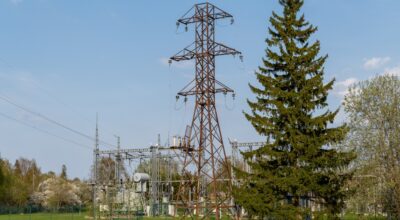The February 2024 issue of T&D World Magazine features an article by NYPA’s Alan Ettlinger. It discusses the New York Power Authority’s (NYPA) use of cutting-edge power line monitoring tech to boost grid resiliency and reliability. The article highlights the work Prisma Photonics have done with NYPA, implementing PrismaPower. Our collaboration with NYPA has focused on leveraging this fiber optic sensing technology to provide real-time insights into power line health. This enabled proactive measures to prevent damage and maintain an uninterrupted electricity supply, even under harsh conditions. This effort sheds light on the critical role of innovative technologies in enhancing grid resilience, a necessity in today’s climate-challenged world.
Power Line Monitoring in the mountains
This journey began in the winter of 2020, responding to the importance of grid resilience in the face of increasingly frequent and severe weather events. We installed a PrismaPower system in a substation to monitor the transmission line from a substation in Gilboa, New York, to another substation, climbing the Catskill Mountains for more than 35 miles (56 km). This power line, due to its position, experiences a wide range of weather conditions, including especially harsh winters with very cold temperatures, significant snowfall, and powerful winds.
For over 24 months, during two winters, the PrismaPower system captured power line data. This was done 24 hours a day and 7 days a week. PrismaPower uses optical fiber sensing, taking advantage of the existing OPGW, the Optical Ground Wire found at the top of the power lines, as a continuous sensor. As there is no need for external sensors on the transmission lines, extreme weather conditions or any interference does not impact it. One of the scenarios we were looking for was icing on the wires. Icing on transmission lines poses significant risks, including power line sagging or snapping, leading to power outages or even catastrophic grid failures. In extreme cases, the weight of the ice can damage not just the wires but the towers themselves.
Detecting Ice on the grid with fiber optic sensing
PrismaPower’s collected data was cross-correlated with several external sources, mainly weather data for that period, to enrich and validate our findings. The external data included precipitation (rain and snow), temperature, and humidity. We wanted to validate the monitored data with external data to demonstrate the accuracy and abilities of long-term power line monitoring.
The resulting dashboard allowed, among other things, to look at the line, with the span suspected of being loaded with icing marked for follow-up. A screen capture of the icing dashboard shows the transmission line spans in question with color coding suggesting different tensions/sag of the lines.

By setting load thresholds on the dashboard, an operations person can further investigate and better understand the load on a suspected span. Ground or air-borne patrols can be used to validate the presence of ice on the wires and if necessary act on it.

Zooming into the map view, the red and orange sections indicate spans which PrismaPower detected increases in loads and correlated it with higher precipitation and lower temperatures. Clicking on one of the icing icons, the operator can see the span’s identification and data in order to send in a patrol.
The long-term benefits of power line monitoring
This initiative has provided NYPA with a useful tool to identify issues on their power lines before they become serious problems. Beyond icing, PrismaPower has the ability to detect more grid problems, such as vandalism acts (e.g., physical tampering with towers), transient electrical events (short circuits and more), and even track partial discharges to enable the utility to plan preventive maintenance, improving both grid reliability and resilience.
The effort coincides with NYPA’s VISION2030 strategic plan, one more step in helping the transition to a carbon-free, economically vibrant New York grid by modernizing and hardening transmission assets and maximizing grid capacity.
In the future, PrismaPower, using the same technology and optical fiber sensing, can help increase capacity on those lines by employing Ambient Adjusted Rating (AAR) – which is mandated by the Federal Energy Regulatory Commission, FERC order 881 or Dynamic Line Rating (DLR).
Our work with NYPA underscores the importance of innovation in the utility sector, moving beyond traditional inspection methods to embrace digital solutions that offer broader coverage, greater accuracy, and the ability to anticipate rather than react to problems. It represents a significant step forward in our journey toward a sustainable, resilient energy future, emphasizing the need for continuous investment in technology and infrastructure to meet the demands of a changing climate and evolving societal needs.
By integrating advanced power line monitoring technologies into the grid, we are setting new standards for reliability, safety, and efficiency, ensuring that the energy system can withstand and adapt to the complexities of the 21st century. As we continue to monitor and analyze the performance of the transmission line since its installation in winter 2020, our commitment remains steadfast: to deliver a resilient grid that meets the needs of all consumers today and in the future.
Icing is a climate-related use case covered by PrismaClimate, which is a part of the PrismaPower suite:

To learn more information about icing detection read all about PrismaClimate.
We want to say a big thanks to the NYPA people, Alan Ettlinger, Zhong Zheng (Kyle), Manuel Hamalian, Lynne Smith, Susan A. Craig, and the rest of the NYPA team.






